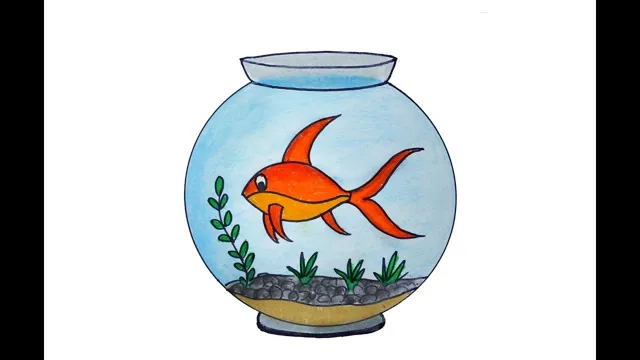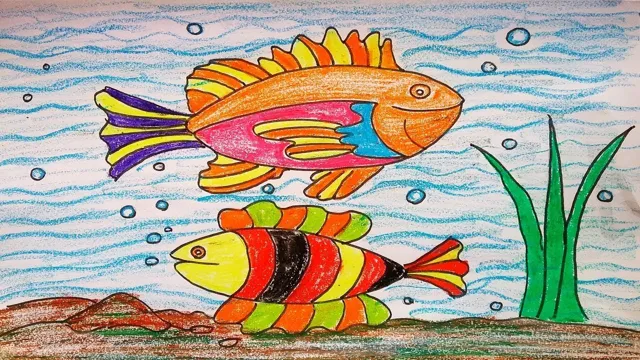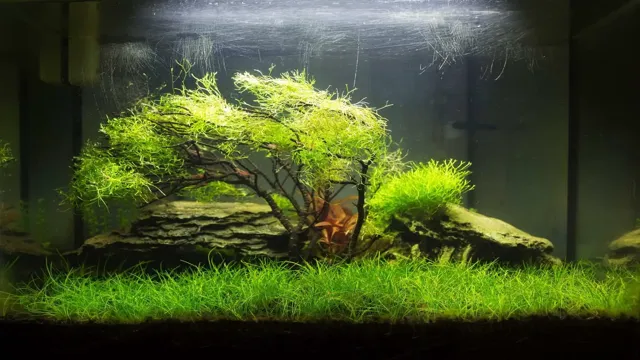Imagine the vibrant colors and graceful movements of fish swimming in your own aquarium. Adding these aquatic creatures can liven up any room and provide a sense of tranquility. However, choosing the right fish for your aquarium may seem daunting.
With so many different species, sizes, and temperaments to consider, how do you know where to start? That’s where drawing fish can come in handy! Not only is it a fun and creative way to research and plan for your ideal aquarium, but it also helps to visualize the different fish species and their unique characteristics. In this blog post, we’ll explore how drawing fish can make your aquarium planning easier and more enjoyable. So grab some paper and pencils and let’s dive in!
Materials Needed
If you’re interested in adding some aquatic art to your aquarium, you might be wondering how to draw fish for aquariums. For starters, you’ll need some basic materials to get started. A sketchpad or drawing paper, pencils (preferably a set of varying hardness), erasers, and a ruler or compass are all must-haves.
If you’re planning to add color to your artwork, you’ll also need colored pencils, markers, or paint. You can even use a digital medium if you prefer, such as drawing software and a tablet. Once you have your materials, it’s time to start practicing your fish-drawing skills.
Start by studying photos or images of the fish you want to draw, observing their shapes, patterns, and colors. Practice sketching basic fish shapes, working on creating accurate proportions and adding in details like fins and scales. Don’t be afraid to experiment with different styles and techniques until you find the perfect look for your aquarium.
With a little practice, you’ll be drawing beautiful fish that will be the envy of all your aquarium-loving friends.
Pencil and paper
When it comes to creating art or writing, one of the most essential materials you’ll need is a pencil and paper. These basic tools allow you to capture your ideas and bring them to life in a tangible form. A pencil provides the versatility of being able to create both light and dark lines, smudge and blend for shading, and erase mistakes.
Paper, on the other hand, comes in a variety of textures, colors, and sizes and can enhance or detract from your artwork depending on your preference. The materials used can impact the outcome of your creativity, and if you’re just starting, it’s best to experiment with different types until you find ones that work for you. Working with pencil and paper can be a cathartic experience, transporting you into a world where nothing matters but the tip of your pencil and the blank canvas in front of you.
The power to bring your imagination to life with pencil and paper is a magical process that beginners and professionals can appreciate alike.

Eraser
If you’re the kind of person who likes to keep your workspace tidy, then you probably have an eraser at the ready for correcting any mistakes you make. But have you ever stopped to think about what materials go into making an eraser? Typically, erasers are made from a combination of materials such as rubber, plastic, and additives like pumice and sulfur. The rubber used in erasers is typically synthetic, created through a process known as polymerization.
This means that it’s created by joining together many small molecules to make larger ones. On top of this, most erasers contain a small amount of plastic to help improve their durability. Finally, additives like pumice and sulfur are included to make the eraser more effective at removing pencil marks.
All of these materials are carefully blended together in order to create an eraser that will provide precise erasing power without leaving smudges or damaging the paper. With many options available in terms of shape, size, and texture, erasers are an essential tool for anyone who wants to maintain a neat and professional appearance in their work.
Fine-tip marker or pen
When it comes to creating detailed sketches, drawings, and doodles, having a fine-tip marker or pen can make all the difference. These materials are essential for anyone wishing to add intricate details to their work. A fine-tip marker or pen is ideal for outlining, adding shading, and highlighting specific areas of a drawing or sketch.
These materials allow for more precision than regular markers or pens, making it easier for artists to create stunning artwork. When choosing a fine-tip marker or pen, it’s essential to consider the thickness of the point. The thinner the point, the more delicate the lines it can create.
This can help you create more intricate details in your artwork, giving it an added level of depth and texture. Overall, investing in a quality fine-tip marker or pen is a wise decision for any artist looking to improve their skills and create more professional-looking artwork.
Selecting Your Fish
When selecting fish for your aquarium, it can be a bit overwhelming with all the different species and varieties available. One important factor to consider is the size of your tank, as certain fish require more space than others. It’s also a good idea to select fish with similar temperaments to avoid any aggressive behavior or bullying among the tank’s inhabitants.
Researching the specific requirements for each fish, such as water temperature and pH level, can ensure their health and longevity in your aquarium. Don’t forget to consider the aesthetic appeal of the fish you choose, as their colors and patterns can add depth and interest to your tank. Once you’ve selected your fish, it’s important to acclimate them to their new environment slowly and monitor them closely for any signs of stress or illness.
All in all, taking the time to carefully choose and care for your fish can lead to a vibrant and thriving aquarium that you can enjoy for years to come. And if you’re feeling artistic, why not try your hand at drawing your new fish friends? With some basic skills and a little bit of practice, anyone can learn how to draw fish for their aquarium.
Research different types of fish
When it comes to selecting fish for your aquarium, there are plenty of different options to consider. One great way to start is by doing research on the different types of fish available. You may want to choose fish based on their size, color, compatibility with other fish, or ease of care.
Some popular types of fish for aquariums include Betta fish, Guppies, Tetras, and Cichlids. Betta fish are known for their bright colors and relatively low-maintenance care, while Guppies are known for their social nature and adaptability to different aquarium conditions. Tetras come in many different colors and are often kept in groups, while Cichlids are popular for their ability to inhabit larger aquariums. (See Also: How to Divide Red Reinecke Aquarium Plant Without Damaging It – A Comprehensive Guide)
Regardless of which type of fish you choose, it’s important to research their specific care needs and ensure that you have the appropriate equipment and space to accommodate them. That way, you can enjoy a healthy and thriving aquarium for years to come.
Select fish that match your skill level
When it comes to selecting fish for your aquarium, it’s important to consider your skill level. As an aquarium owner, you want to make sure that your fish thrive in their environment. To do that, you need to choose fish that can live comfortably in the conditions you provide.
So, before you start selecting fish, evaluate your level of experience and knowledge. If you’re new to aquariums, it’s best to start with low-maintenance fish, such as tetras or goldfish. They’re sturdy and can tolerate fluctuations in water conditions.
However, if you’re more experienced, you might want to consider more exotic fish, such as cichlids or angelfish, which require precise water conditions and specific diets. Remember, it’s better to start small and work your way up than to overwhelm yourself with high-maintenance fish that are beyond your expertise.
Sketching Your Fish
Drawing fish for your aquarium can be a fun and rewarding experience, but it can also be challenging if you’re not sure how to get started. One great way to begin is by sketching your fish before you start to draw. This will allow you to get a feel for the shape and movement of the fish, as well as the details that make it unique.
To begin, choose a fish that you want to draw and study its body carefully. Pay attention to the curves and angles of its body, the shape of its fins and tail, and any distinctive markings or features. Then, start to sketch lightly, using simple shapes and lines to capture the basic form of the fish.
As you continue to work, gradually add more detail and texture, using shading and cross-hatching to create depth and dimension. Don’t be afraid to experiment and make mistakes – this is all part of the learning process and can lead to some surprising and beautiful results. With some practice, patience, and creativity, you can learn how to draw fish for your aquarium with confidence and skill.
Start with basic shapes
When it comes to sketching a fish, the first step is to start with basic shapes. This fundamental technique can help you to visualize the proportions of the fish more easily. Begin by lightly drawing a circle for the head, followed by a larger teardrop shape for the body.
From there, add a triangle shape for the tail and small circular shapes for the fins. By starting with basic shapes, you’ll be able to build upon your drawing with more intricate details. It’s important to keep your lines light at this stage, as you’ll be making adjustments as you progress.
Once you have the foundation of your fish sketched out, you can move on to adding more detail and refining your drawing. With practice, you’ll be able to create more lifelike and intricate fish drawings. So, grab a piece of paper and start sketching your fish today!
Build up details and texture
When sketching your fish, it’s important to build up the details and texture to make your artwork come to life. Start by observing your fish closely, noticing its unique features and markings. You can then begin to sketch out the basic shapes of your fish, using light strokes to create a rough outline.
Next, focus on adding texture to your sketch by varying the thickness and direction of your lines. This will help to create the illusion of scales and add depth to your drawing. Take your time as you work on adding details, gradually building up the complexity of your sketch.
Remember, the key is to be patient and observant, allowing the natural beauty of your fish to shine through in your art. So grab a pencil and paper and start exploring the world of fish sketching today!
Use reference images or live fish for accuracy
When it comes to sketching your fish, there are a few things that you should keep in mind if you want your drawings to be accurate and lifelike. One of the most important things to consider is using reference images or even live fish when you can. This will help you get a better sense of the fish’s shape, proportion, and details, and it will help ensure that your sketches capture the essence of the fish you’re trying to draw.
Without a reference, it can be easy to fall into the trap of relying on your memory of what a fish looks like, which can be surprisingly inaccurate. Even if you’ve seen a lot of fish in your life, each species has its own unique features and quirks, and it can be hard to remember them all without referencing something. Using reference images can help you solve this problem, especially if you’re working on a particularly tricky fish.
You can find images online of just about any species, and you can use them to study the fish’s proportions, color, and more. If you’re lucky enough to have access to live fish, even better! You can observe the fish firsthand and really get a feel for its movements, shape, and behavior. So if you want to take your fish sketching to the next level, make sure to use reference images or live fish whenever possible.
Not only will it help you create more accurate and lifelike drawings, but it will also help you deepen your understanding of these fascinating creatures.
Inking Your Fish
If you’re looking to add some artistic flair to your aquarium, why not try your hand at drawing some fish? It may seem daunting at first, but with some practice and patience, you can create some stunning additions to your underwater world. When it comes to inking your fish, there are a few tips to keep in mind. First, make sure you have the right tools on hand.
A fine-tipped pen or marker will give you the precision you need. Next, do some research on the types of fish you want to draw, paying attention to their shapes, patterns, and colors. Finally, take your time, working in small sections to ensure you’re happy with each part before moving on.
By putting in some effort and paying attention to the details, you’ll soon have a beautiful school of fish swimming right on your aquarium wall. (See Also: How to Make a Self Sustaining Ecosystem Aquarium: A Step-by-Step Guide)
Outline your pencil sketch with a pen or marker
When it comes to creating your fish drawing, inking is an important step to bring it to life. Inking is the process of outlining your pencil sketch with a pen or marker to create bold lines and clean edges. This step not only helps to define the shape of your fish, but it also adds depth and detail to your drawing.
Using a fine-tipped pen or marker, carefully trace along the pencil lines, adding shading and texture where needed. You may also want to experiment with different line weights to create variation in your drawing. Remember to take your time and be patient during the inking process, as it can be easy to make mistakes.
With a steady hand and some practice, you can create a beautiful fish drawing that truly stands out. So, grab your pen or marker and let’s get inking!
Add details and shading with cross-hatching
When it comes to inking your fish, adding details and shading with cross-hatching can take your drawing to the next level. Cross-hatching is a shading technique that involves creating a series of parallel lines that intersect with each other in varying directions, creating a mesh-like pattern. This can add depth, texture, and dimension to your drawing.
To achieve the perfect cross-hatching effect, start by using a fine-tipped pen or brush to create your first set of parallel lines. These lines should be evenly spaced and in the direction of the shape you are shading. Then, create a second set of lines that intersect with the first set at a perpendicular angle.
Continue adding sets of parallel lines until you have achieved the desired level of shading. Remember to vary the density and direction of the lines for a more natural look. With a little practice, cross-hatching can become a valuable tool in your inking arsenal, helping to bring your fish to life on paper.
Coloring Your Fish
If you’re looking to add some color to your aquarium, there are a few things you can do to make your fish stand out. First of all, it’s important to know what types of fish you have and what colors they naturally exhibit. Some fish might be more vibrant than others, but you can also enhance their colors by providing a healthy diet and maintaining a clean environment.
Additionally, you can introduce plants and decorations that complement your fish’s colors and create a visually pleasing landscape. Lastly, if you’re feeling creative, you can draw your own fish to display on the aquarium walls. Don’t worry if you’re not a professional artist – there are plenty of tutorials and guides available online that can teach you how to draw fish for your aquarium.
With a little bit of effort and imagination, you can transform your aquarium into a colorful and lively underwater world!
Choose colored pencils or watercolor paints
When it comes to coloring your fish, there are two main options to choose from: colored pencils or watercolor paints. Colored pencils offer a more precise, controlled coloring experience, allowing you to create intricate details and shading. On the other hand, watercolor paints offer a more fluid, organic feel, perfect for creating a more natural, underwater look to your fish.
If you’re looking for a more traditional coloring experience, colored pencils are the way to go. They allow you to layer and blend colors, creating a wide range of hues and tones. This makes them ideal for creating detailed patterns and designs on your fish, as well as shading to give your fish a more three-dimensional look.
Plus, pencils are easy to use and require minimal cleanup, making them a convenient choice for busy artists. On the other hand, watercolor paints offer a more free-form approach to coloring your fish. With their fluid nature, they create a natural, watery effect, perfect for portraying an underwater scene.
The colors blend together seamlessly, making it easy to create smooth transitions from one color to another. However, watercolors require a bit more skill to use effectively, and they can be messier than colored pencils. But for those willing to put in the effort, the results can be stunning.
Ultimately, the choice between colored pencils and watercolor paints comes down to personal preference. Both offer unique benefits and can be used to create beautiful, eye-catching fish images, so experiment with both and see which one works best for you!
Blend colors for a realistic look
When it comes to coloring your fish, you want it to look as realistic as possible. One of the best ways to achieve this is by blending colors. Instead of using one flat color, blending different shades together can create depth and dimension.
For example, if you are coloring a red fish, adding in some pink or orange can give it a more lifelike appearance. Take some time to experiment with different color combinations and blend them together until you achieve the desired effect. With a little practice, you can create a beautiful and realistic-looking fish that is sure to impress.
Remember, blending colors is the key to achieving a lifelike appearance when coloring your fish.
Displaying Your Fish Drawing
So, you’ve learned how to draw fish for your aquarium, but now you’re wondering how to display your artwork? This can be done in a variety of ways. One option is to simply hang the drawing on the wall near the aquarium. This allows you to enjoy both the live fish and your artistic rendering at the same time.
Another option is to frame the drawing and place it on a shelf or table near the aquarium. This creates an elegant display that showcases your artistic talent. You could even use the drawing as inspiration for decorating the entire room where the aquarium is located. (See Also: Where to Place Wavemaker in Freshwater Aquarium: A Comprehensive Guide)
The possibilities are endless! Whatever method you choose, displaying your fish drawing is a great way to show off your love for fish and aquariums while also adding a personal touch to your home decor.
Frame your drawing or add it to your aquarium
If you’ve drawn an amazing fish painting, you’ll want to show it off to the world. There are many ways to frame and display your artwork. One option is to buy a ready-made frame that fits your drawing and hang it on your wall.
If you’d like to be more creative, consider putting it in an aquarium. Fish and art are a perfect combination! You can simply tape or glue your painting to the outside of the aquarium, or even slide it into a clear plastic sleeve to protect it from water damage. When your aquarium is full of beautiful fish, your artwork will add an extra pop to the scene.
You can also take a picture of your drawing with your fish and post it on social media to share your creativity with others. Displaying your fish drawing is fun and easy, and it’s a great way to showcase your artistic talent and love for sea life. So, get creative and find the perfect spot to show off your fish masterpiece!
Share your art with others on social media
If you’re proud of your fish drawing and want to share it with the world, social media is the perfect platform to do so. Whether you use Instagram, Facebook, or Twitter, there are millions of people out there who would love to see your artwork. To make your post more eye-catching and engaging, consider adding a caption that explains the story behind your drawing.
Perhaps you were inspired by a recent trip to the aquarium, or maybe fishing is your favorite hobby. Whatever the case may be, sharing your artistic process and inspiration can help your followers connect with you on a more personal level. When you post your fish drawing, use keywords like “art” and “fish” to help your post get noticed by as many people as possible.
Additionally, you can use hashtags to make it easier for people who are interested in art or fish to find your post. For example, using #fishdrawing or #artisticfish can help your post to stand out from the crowd. Overall, sharing your art on social media is a great way to connect with other artists and enthusiasts who share your passion for fish.
Conclusion
In conclusion, drawing fish for your aquarium may seem like a daunting task, but with a few simple techniques, it can become a relaxing and enjoyable hobby. Remember to pay attention to the details, such as the shape and color of the fish, as well as the environment in which they live. Don’t be afraid to experiment with different techniques and mediums, and most importantly, have fun! Just like the fish in your aquarium, your art is meant to be admired and appreciated.
So, go ahead and dive right in!”
FAQs
What materials do I need to draw a fish for my aquarium?
You will need paper, pencils/pens/markers, and an eraser.
Are there any helpful tutorials or resources for drawing a fish for my aquarium?
Yes, there are many online resources such as YouTube tutorials and step-by-step guides available on art websites.
How do I begin drawing a fish for my aquarium?
Start by sketching the basic shape of the fish, using simple shapes such as circles, ovals, or rectangles.
What are some tips for making my fish drawing more realistic?
Focus on adding details such as the fish’s scales, fins, and eyes. Pay attention to the proportions and shape of the fish’s body.
Can I incorporate other elements into my fish drawing to make it more interesting?
Absolutely! You can draw plants, rocks, or other aquatic animals to create a full aquarium scene.
How do I choose the right colors for my fish drawing?
Research the specific species of fish you want to draw and use reference photos to accurately match the colors and patterns.
Do I need to have previous drawing experience to draw a fish for my aquarium?
No, anyone can learn to draw a fish with practice and patience. Start with simple shapes and work your way up to more complex designs.







